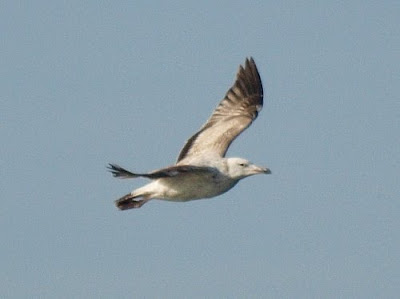Red-throated Diver 4E
Black-throated Diver 1 s/p
Canada Goose 2E, 2W, 2 in off
Shelduck 8E
Merganser 17E
Scoter 87E, 3W
Shoveler 7E
Kestrel 1
Curlew 4E
Arctic Skua 5E
Bonxie 1E
Lesser Black-backed Gull 1 ad. graellsii
Black-headed Gull 60
Little Gull 8E
Sandwich Tern 106E
Commic Tern 71E
Little Tern 2E
Tawny Owl 1
Swallow 12
Sand Martin 3
House Martin 1
Wheatear 4
Pied Wagtail 3
White Wagtail 1
alba Wagtail 1
Whitethroat 10
Blackcap 7
Chiffchaff 12
Willow Warbler 3
Raven 2
Carrion Crow 11 in off sea
Small White 2
Small Copper 1
Brimstone 2
Peacock 5
Small Tortoiseshell 4
Cetacean sp. 2-3 off Birling Gap


Male Blackcap in Belle Tout Wood
West Rise Marsh
Caspian Gull 1 first-summer ex. c.5.30-6pm
Sedge Warbler 2

Male Wheatear at West Rise Marsh














First-summer Caspian Gull at West Rise Marsh, Eastbourne
Aged as a first-summer based on its advanced appearance, predominantly by virtue of what appear fresh third-generation largely plain silvery-grey mantle and scapular feathers, but as it hasn't yet dropped p1, this individual is perhaps best still described as an abraded first-winter. It's suddenly tempting to describe it as a second calendar-year bird!
Despite its faded bleached appearance this remains a rather straightforward identification of a 'classic individual' based on the following:
its very long, slender bill with a white base to the lower mandible, and tiny white tip. At most angles its bill appeared black, but in the strong light and especially when facing slightly away, the basal two thirds of both mandibles were a dull dirty-pink, being clearly blacker distally.
its small pear-shaped white head, punctured by its small dark eyes set amidst pure white eyelids. Long sloping forehead accentuated whilst in flight. Long white loral area. Long gape-line extending back to below its eye. Its white head set-off against a grey necklace of hindneck streaking that extended onto the sides of the neck and breast.
very long snake-like white neck, at times peculiarly kinked and bulging. Protruding bulging breast. Hanging belly (ventral bulge) even apparent in flight. Gleaming white body and undertail-coverts.
pale silvery-grey scapulars and mantle feathers virtually unmarked save for their darker grey shaft-streaks.
its first-generation dark brown tertial centres with narrow thumbnail-like white tips and narrow white edges restricted to the outer half of each feather.
pure white rump and tail-base contrasting strongly with broad black tail band.
very long-winged, that when at rest and viewed 'side-on', the tail-tip to wing-tip length was seen to easily exceed the tertial tip to tail tip length.
predominantly white underwing-coverts and axillaries forming a solid white 'mid-wing' area.
in flight a distinctive venetian blind patterned pale inner primary window created by the outer webs of each inner primary being dark including p1 (p1 is pale in Herring Gull). From the lowest image above, pale lozenges on the dark outer webs on p2 to p4 are readily discernible. Broad white tips to the dark secondaries.
pale pink legs.
it was slightly larger than many of the surrounding argenteus so most-probably a male.
it is entirely consistent for the species to appear extremely bleached and abraded by Spring, with the once blackish areas faded brown, and the sun-bleached wing-coverts to lack any clear pattern. Note the strong similarity of the West Rise Marsh bird to that portrayed in Plate 64 BB Vol. 103 p.155 photographed in March.
Arlington Reservoir
Cuckoo h
Swallow c.6
probable Nordic Jackdaw 1
































